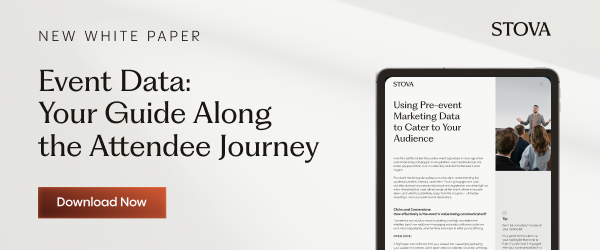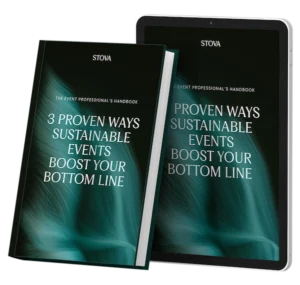4 Analytics Best Practices for Maximizing Data Insights
February 14, 2025

It’s one thing to be a data-literate event planner who can collect data and attribute it to a set of predetermined key performance indicators (KPIs). It’s quite another to develop fully data-led strategies for understanding and addressing an audience’s needs throughout their lifecycle.
Those who are gunning for more responsibility and a higher strategic value within their organization need to master the latter.
As a follow up to our guide to collecting and using data throughout the attendee journey, this article will focus on some strategies and frameworks for actually applying your data and deriving insights that you can action.
1. Journey Mapping
Event intelligence allows organizers to segment prospective attendees based on where they are in the buyer’s journey in order to optimize engagement at every step based on their awareness of you (and your offering), their level of interest, and their readiness/authority to make a decision to register.
For example, a simple way to segment your prospects is in terms of where they fall on a marketing funnel. The “funnel” analogy is used to visualize the path a prospective registrant takes from being someone who knows nothing about you to developing an awareness and an interest in you and, eventually, to registering for your event. At a high level, funnel-based segmentation might divide this path into three stages – e.g. early (research) stage, consideration stage, and decision stage.
Early-stage attendees are those engaging with general educational content about the industry, and you might be interacting with them directly through your published content or, more likely, peripherally through others’ content and events. Outreach at this stage generally focuses on audiences that aren’t yours already. What does that look like? Comments and discussions on influencer social media posts, blog articles or other assets that you’ve commissioned with industry publications or trade associations, interactions at other industry events, etc. Prospects at this stage are superficially aware of you but have the lowest level of commitment to your brand and your event.
Consideration-stage attendees show more of a readiness to register by interacting with your brand directly on your website, subscribing to your newsletter, etc. They are aware of you and use you as a resource but are not actively looking for an event like yours to attend right now. Often marketing efforts geared towards this segment of your audience are designed to endear them to your brand, generate trust, and maintain a holding pattern of attention and engagement so that, when it actually is time to register, you have their attention.
Decision-stage attendees are visiting your event landing page, clicking on your event announcement emails, and attending your free ancillary events, webinars, and promotional sessions. They’re also more likely to be actively engaging with your social posts or comments. While you want to use calls to action throughout your marketing engagements to drive people to this stage of the funnel, the calls to action here are typically to register.
This is a high-level example. When you segment your audience, you may benefit from a more granular segmentation based on specific points of engagement. Data from your event and marketing tech stack can be crucial for defining these more granular stages, and you’ll ideally want a customer relationship management tool that can manage (or at least track) these interactions from the start of your engagement through to the event itself. That’s why Stova has built a suite of marketing automation tools to complement its event management platform. All the data from throughout your marketing funnel can then be collated into custom dashboards that let you visualize that engagement to determine how well your efforts are paying off.

2. Personalization
Depending on how niche your event is, you may also want to create different segments based on audience persona that allow you to further define which types of outreach, channels, or messaging will be most effective. This can help you tailor your engagement not only to their stage in the buyer’s journey but who they are as a customer/stakeholder and what they are specifically looking for.
For example, a B2B trade show for the fintech industry might determine that enterprise decision-makers (c-suite, VPs, heads of departments) respond to messaging that conveys the event’s ability to deliver high-level strategic insights, networking with other executives, potential vendors for long-term partnerships, etc. There may also be specific channels they are more likely to use when learning about new events, like exclusive networks for other professionals in their category.
Conversely, startup founders and early-stage entrepreneurs are likely more concerned about market exposure, investor connections, and broad industry trends. They are more likely to consume a breadth of content and have less access to highly curated, exclusive channels.
The value of personalization extends beyond marketing and throughout the event experience. A key challenge – especially for large-scale events – is meeting the needs of a wide range of stakeholders. How do you find a balance that lets you include sessions, potential contacts, education, and business opportunities for everyone while keeping the event simple enough to navigate?
By using a platform that helps you collect and catalogue this audience and attendee data.
The trick to satisfying all these needs while keeping the experience simple and straightforward for attendees is to package them and present them on a silver platter. Stova allows you to collect all the relevant attendee data so you can tailor onsite alerts and other communications, recommend relevant sessions, and offer more effective networking through curated lists based on personal criteria. Personalized offerings presented on a silver platter increase an attendees brand loyalty by not only helping them derive more value from the event, but making the event feel tailor-made for them.
3. Future-proofing
As any industry gets more saturated and competitive, event organizers that service it need to both figure out how to differentiate themselves and gain insights into how their audience feels about their offerings.
A pitfall of trying to evaluate your event performance with too little data is the tendency to give too much weight to certain obvious, easy-to-track metrics, like attendance. Attendance is a fine indicator of how well you marketed your event, and also indicates how valuable your previous events were, but it’s a poor indicator of how well the current event itself went. This is because those numbers are determined before the event actually happens. Data points like these are called “lagging” indicators because they look back at what has already happened rather than being helpful when projecting your outlook into the future.
Conversely, understanding your leading indicators ensures that you continue to deliver the value your attendees look to you to provide. Data that supports future-proofing your business involves things like engagement and sentiment. Engagement data can include things like
- How many sessions the average person attended
- How many stuck around until the end of a given session
- How many clicked on or reacted to a virtual stream
- How many people “liked” or commented on a session content
- How much an event was shared on social media
- How many connections were made at the event
Because attendees who actively participate in sessions, visit multiple booths, and network extensively are more likely to return, these metrics are strong indicators of an attendee’s likelihood of registering for the event again next time. Similarly, if attendees followed a curated event journey based on their specific interests and engagement history, they are more likely to feel the event met their needs.
You can also track follow-up activity and other post-event interactions, such as opening recap emails, downloading materials, or engaging with post-event surveys. Anything that indicates a sustained interest in the event lends itself to the idea that you’ve captivated your attendees’ attention, and that you’re in a strong position to hold it with ongoing touchpoints. A thriving event-driven community means attendees will want to return.
Sentiment data basically provides context to engagement (and other) data by shedding light on how well the event and its components were received. The most common way to collect this data is through surveys, although some platforms allow you to streamline this in specific instances. For example, rather than asking multiple questions in a post-session survey, you might just let people give it a thumbs up or a thumbs down as a way to generate an approval rating. The advantage is that, while full surveys can be onerous to fill out and often suffer from poor response rates, a simple binary rating is relatively easy for attendees to complete. However, you do still want to ask open-ended questions at some point or to a representative group of your stakeholders as this feedback is crucial for understanding why people responded the way they did.
4. Multi-faceted Stakeholder Analysis
“Stakeholders” was a deliberate choice of words there. While your attendee experience should be prioritized, attendees are not the only stakeholders. Other participants, like speakers, sponsors and exhibitors, all benefit from a smoothly-running event. Ensuring they stay happy and unobstructed in their own value delivery is critical for making sure everyone continues to get what they need from the event.
Failing to consider non-attendee stakeholders in your event intelligence strategy can have costly consequences. Speakers whose sessions are under-marketed may suffer from poor attendance and opt out of future events. If sponsors and exhibitors, the financial backbone of many events, are unimpressed by their engagement, they may do the same – which could be very costly. The risk of either stakeholder type having a bad experience goes beyond their individual retention. Anyone who doesn’t derive enough value from the event carries the risk of becoming a detractor and making it more difficult to attract others to future events.
Speakers, Panelists and Moderators. The same data you’re likely collecting to evaluate whether the speaker made an impact can be used to substantiate the event’s value back to them: session attendance numbers, engagement metrics (poll responses, Q&A participation, etc), and social media mentions and shares of their session content.
Event intelligence can be used to improve both their performance and their experience. Analyze registration trends to identify under-registered sessions early. By tracking interest levels, you can deploy additional marketing efforts like targeted emails or in-app notifications to boost attendance. Post-event data, like survey responses or sessions accessed on-demand, can also be used to provide speakers with personalized reports showcasing their session impact, reinforcing their value in participating again.
Sponsors and Exhibitors. Ultimately, these stakeholders care about driving meaningful connections that they can use to fill their sales pipelines. Sponsors and exhibitors expect clear value for their investment. If they don’t see a strong return in visibility, lead generation, or attendee engagement, they may reconsider their investment in future events, which weakens the event’s marketplace appeal and reduces sponsorship opportunities.
Brand impression metrics from booth traffic and dwell time, logo visibility on event materials, digital impressions, etc. are a solid start to justifying the event to sponsors and exhibitors. But to really demonstrate that you’ve been able to curate a qualified audience, these should be combined with engagement metrics. Stova’s robust lead capture functionality helps exhibitors swiftly and conveniently collect lead information, but it also gives you an easy way to track just how many conversations a given exhibitor has had (e.g. by looking at the number of badges scanned). Tracking sponsored sessions and activations is another great way to justify the ROI on assets and event elements that you might be selling at a premium, and can be complemented by metrics around the number of follow-up meetings set through the mobile event app or virtual event platform.
If engagement with a sponsor’s activation is low, event organizers can send push notifications to drive traffic or offer prime speaking slots in future programming. Post-event reports with detailed analytics on brand exposure and engagement provide sponsors with clear proof of value, increasing their likelihood of reinvesting.
Press and Media. Press coverage is a massive value-add to many types of events, from trade shows and conferences to big ticket customer-facing corporate events, like product launches or user conferences. However, depending on how well-established the event already is, press coverage might be something you have to strive for.
Generally, press passes are provided for free under the expectation that media representatives will review the event, create event highlights for their own audiences, interview influencers at the event, etc. All of these tasks serve to validate the event, expand its reach, and generally raise its profile.
But even if the ticket is covered, media agents still have to justify their time and any travel or hotel expenses entailed in covering your event, so it’s helpful to understand what they care about. Firstly, they want to make sure they’re covering something their audience has an interest in, and that your event has an interesting impact on the industry. Figures that lend themselves to this metric include basic stats like the number of attendees, exhibitors, sessions, and speakers – stuff you might already include in their media package by default. Any decent event platform should make this data readily available and easy to deliver. Other data that indicates how well-received your event was, like your event’s NPS score (if it’s something you’re proud of), positive ratings of keynotes or sessions, engagement on your mobile or virtual platforms, and the number of shares or hashtag uses on social media, can also help. However, if you want them to report any of these figures, you should be prepared to substantiate them by providing the raw data (with any personally identifiable information redacted).
If partnering with any media outlets to produce certain assets for the event, like proprietary research or white papers, they will likely also expect data to demonstrate performance on your channels. (A major reason for you to do that is to gain access to their audience and bolster registration – especially if you’re paying them, and you should be asking for the same.)
Media representatives are also often influencers themselves, and major industry events often serve as important networking opportunities for them. As such, the number of attendees, speakers, and any professional demographic breakdown can help them make the case to their editors to cover the event.
Social media is useful for tracking press activity and sentiment, as are requests received for interviews or quotations. Try to use your event hashtag together with these touchpoints to identify gaps in media engagement. If key journalists or publications are not generating expected coverage, try proactively offering additional interviews, exclusive content, or invitations to networking events. A centralized press hub with real-time access to speaker statements, event updates, and multimedia assets can also help journalists efficiently produce content to maximize event visibility.
Conclusion
Effective event intelligence goes beyond merely collecting data – it’s about leveraging insights to optimize engagement, personalize experiences, and future-proof your event strategy. Mapping out the audience segments according to their level of interest, familiarity with the event brand, and readiness to register can help you tailor your messaging and marketing efforts to nurture prospects, making them more disposed to register when the time comes.
Curating personalized event experiences and ensuring that each stakeholder receives a positive ROI strengthens long-term brand loyalty, while complementing your data with qualitative sentiment analysis helps you stay ahead of the curve. Tracking the right mix of leading and lagging indicators ensures that decisions are data-driven, improving both attendee satisfaction and your event’s impact.
Beyond attendees, a holistic data strategy considers the value to all stakeholders, including speakers, exhibitors, sponsors, and media. Whether it’s using analytics to boost session attendance, track exhibitor engagement, or secure stronger media coverage, event intelligence can play a crucial role in driving success for all participants.
To see how Stova’s event intelligence capabilities support a holistic data strategy that keeps all stakeholders satisfied, engaged, and eager to return, book a demo now.
Whether your event is virtual, hybrid, or in-person, enhance your attendee’s journey with an event ecosystem built for your audience. Ready to walk through Stova's event technology solutions? Schedule some time with us today.

